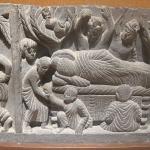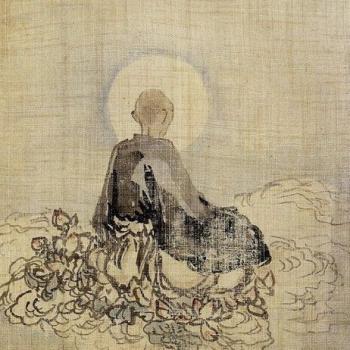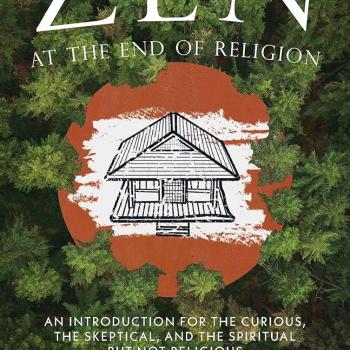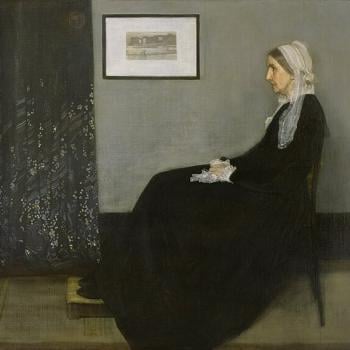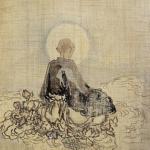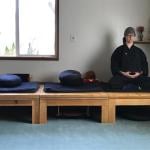
attributed to Kanō Eitoku
1590
(At our Empty Moon Zen Rohatsu retreat at the end of the year there were several outstanding talks on our intimate way. I’ve asked the speakers if I could reprint them at my blog, and each graciously agreed. Here I offer the last of these, this from Thomas Wardle, a Dharma Holder within our Zen lineage.)
The Case:
The priest Xiangyan (Kyogen) said, “It is as though you were up in a tree, hanging from a branch with your teeth. Your hands and feet can’t touch any branch. Someone appears beneath the tree and asks, ‘What is the meaning of Bodhidharma’s coming from the West?’ If you do not answer, you evade your responsibility. If you do answer, you lose your life. What do you do?”
A Comment:
Even though your eloquence flows like a river, it is all to no avail. Even if you can expound the Great Tripitaka, it is also of no use. If you can really answer it, you will revive the dead and kill the living. If, however, you are unable to answer, wait for Maitreya to come and ask him.
The Verse:
Xiangyan is just blabbing nonsense;
His poisonous intentions are limitless.
He stops up the monks’ mouths,
Making his whole body a demon eye.
Gateless Gate, Case 5
Zen is a great experiment, one of the longest-running in human history, and each of you are active participants.
Zen is an experiment in awakening, in what it means to live this strange human life, and the koan literature we inherit from our ancestors are field notes in this experiment. Each case is a story of awakening and an invitation to experience that awakening for ourselves.
Awakening is just an experience, and like all experiences, it is fleeting, so it can be useful to practice remembering what it is like to be in that place where the veil becomes thin, down becomes up, empty full, and the separation between you, me, and all beings falls away. Koan invite us to find awakening again and again, first right here, then over there, then from underneath a rock, atop a mountain, or in this case, dangling precariously from a branch, high up in a tree.
If you are not already practicing koan but are interested, first seek stability in your own practice. As James often reminds us, awakening is an accident, and our practice makes us accident prone. So build a practice for yourself, and I would encourage you to start small. Five minutes a day is a good beginning. Do not punish yourself. Instead, nurture it and let it grow naturally, over time. Participating in community is also an important part of practice, so I encourage you to seek out other practitioners and join together in the grand experiment that is Zen. Find a teacher and speak to them about koan. You may have several such opportunities during this retreat. Please don’t miss them.
Koan are invitations to intimacy. Our way is to study a curriculum of koan, but historically it was perhaps even more common to spend one’s whole life working with a single case. Their depths are bottomless, just like yours, and while we all have our affinities for certain koan over others, each case is a complete path, so I invite you to get curious whenever a koan seems flat or thin to you.
This case invites you to find your life in a tree and in a question, but honestly it asks a pretty weird question: “What is the meaning of Bodhidharma coming from the West?”
Well, what the hell does that mean? You could be forgiven for feeling it is a bit abstruse, but listen again, listen to the heart-longing, to the desperate sincerity of the asker: “What is the meaning of Bodhidharma coming from the West?”
This koan comes to us from China by way of Japan, and as such, it is translated from languages radically different from our own. A translation of a translation in fact, passed from mouth to mouth through centuries, traversing thousands of miles just to reach you.
Translation is more art than science, and it can be helpful sometimes to look at different translations. David Hinton renders this question as “That ch’i mind Bodhidharma brought from the West: what is it?” Perhaps that is helpful to you, but don’t let this become an intellectual exercise or one of definitions. I invite you to make the question your own. The words don’t matter too much. In the end, there is really only one question, and the whole world asks it. It is beyond words, but if you listen carefully, your heart will hear it.
Do you hear?
Good. Now, who hears?
The question is critically important, and we must explore the matter deeply, but this case first puts us up a tree. Dangling by our teeth with no limbs in reach, we are stuck. Trapped. This is an example of a “No Way Out” case, and you best get used to it, because it is a common device in koan. And koan are just microcosms of our lives, the whole universe reduced to a short story, small but complete unto itself, reflecting the very essence of our lives. Indeed our lives are just like this: no way out.
The invitation of koan is to awaken, and the theme of this retreat is Awakening to the World. Sounds nice, doesn’t it? Sounds sweet. So easy to imagine a happy ending from there: wake up and live happily ever after. But what about awakening to a world that seems overflowing with hurt? To a world fraught with uncertainty? To a world full of very good reasons to be afraid? When I think beyond the walls of this retreat center, these are many of the feelings that arise for me. We live in what are in many ways very scary times, and recent events give us a great many reasons for fear. So what do we do when awakening to a world that seems so out of sorts? That is so far from how we wish it to be?
Stuck up a tree, dangling from our teeth. No way out.
A natural reaction to fear, uncertainty, or a threat is to seek a way out, but today I would like to explore the interesting possibility of what can happen when we stop trying to escape.
Stuck up a tree, dangling from our teeth. No way out.
It is easy to think that this moment in history is unique or special, or perhaps more dire than any that have come before. We are prone to this way of thinking, that this moment is somehow special, that we are ever on the cusp of history. Lewis Carrol called it “chronological snobbery”, but Buddhism invites us into an alternative perspective. In the First Noble Truth, our founding teacher observed that the nature of existence is suffering. Speaking of translations, I’ve always found that one to be a bit… depressing. Saying that life is suffering comes across as one sided, heavy handed, and often unhelpful. In the original Pali, the word used is dukkha, and it is much more nuanced than “suffering.” Dukkha is perhaps better translated as “disquiet,” and etymologically it refers to a wheel with an axle that is slightly off center.
Take a moment and imagine the ride.
Whether you think of it as dukkha, suffering, or disquiet, the observation here is that life is inherently uncomfortable. It is always changing and rarely, if ever, lives up to our expectations, and that is a very important observation. It means that things aren’t personal, and though we may tell stories about it, life defies our explanations about cause and effect. We may point to a host of circumstances in the world today as explanations for our pain, our fear, or why things are completely fucked, but ultimately explanations are just a sophisticated way of trying to escape. We are using our most powerful tool, our minds, to create something solid in the roiling sea of causation. It is just another way of trying to get out.
Please, if only for a moment, stop.
Stuck up a tree, dangling from our teeth.
The things of the world are as they are. This is what we have to take responsibility for. Don’t speak of better days or how you wish it were.
You are completely trapped.
No way out.
Stuck up a tree, hanging by your teeth.
Now what?
When we stop trying to escape, new possibilities emerge, and if we pay attention, we may discover that things are not as we think them to be.
I studied for many years with Bernie Glassman, founder of the Zen Peacemakers, and I continue to find his teaching of the Three Tenets profoundly useful, especially in fraught times such as these. Perhaps you will, too.
The first tenet is Not Knowing. As we often say in Zen, not knowing is most intimate. Our minds perceive patterns in the world, we think, form opinions, tell stories. And the more we do so, the farther away we are from what is right under our feet. The chant we use to introduce dharma talks says “The unsurpassed, profound, and wondrous dharma is rarely met with, even in a hundred, thousand, million kalpas.
Ok.
It is also met with every damn moment of every damn day, mundane and profound in equal proportion, and right up in our faces. If we pay careful attention, we just might notice it.
The dharma leaves nothing out.
I say again: the Dharma leaves nothing and no one out.
I am a great admirer of the feminist film maker Cassie Jaye. She built her career on powerful films about women’s issues and LGBTQ rights (which are human issues and human rights), and after her early success, she began making a documentary about the men’s rights movement. She found the very concept offensive and intended her film as an expose of bigotry and ignorance at work in our society. She interviewed more than 40 men involved in such groups, and what she heard from them appalled her. She found these men to be ignorant and misogynistic, exactly the sort of men who create so many problems in the world today, particularly for women. Then one day while editing the interviews, she realized something profound: she hadn’t been listening. When she went back and reviewed the recordings, she discovered that actually none of these men had said anything particularly offensive, but she had heard misogyny in their words because she expected to hear it. She felt that by talking about men’s issues, these men were inherently denying the importance of women’s issues, as if it were some kind of contest about what was more important. When she listened again, she found instead that while she didn’t agree with everything they said, these men were raising serious and legitimate issues about what they experience in today’s world. Hearing the interviews again, she experienced the power of listening openly and trying to see the world through another’s eyes. What she discovered is the Second Tenet: Bearing Witness.
When we bear witness, it is not just bearing witness to others or that which is outside of us. It is critical that we also bear witness to ourselves, to what arises within us, to how we respond to our experience of the world. We must meet all of this as openly as we can, responding with as much compassion to what arises within as well as to what arises without. And here I would add a small etymological note because I love language and I’m a bit of a pedant: compassion literally means “to suffer with”.
There is a wonderful line from our ancestor, Tung-shan Liang-chieh:
He is the same as me
Yet I am not he
Consider this carefully.
So the first two tenets are not knowing and bearing witness. Fine. But then what? What do I actually do?
Buddhism is not a complacent path, and just as we must respond to the koan, so to must we respond to our lives. In fact, there is no difference. The third tenet guides us in how we respond, and it invites us to loving action.
A great hero of mine is Daryl Davis, a black man who has gotten hundreds of people to leave the Ku Klux Klan simply by befriending them. Notice that I said “gotten” and not “convinced.” That is important. His story is truly extraordinary, and you can learn more about him on YouTube or in the documentary “Accidental Courtesy.” His first experience of racism as a ten year old boy left him with the question, “How can they hate me if they don’t even know me?” and he has held on to that question throughout his life. Asking that question allowed Daryl to respond with kindness when a white man paid him a back-handed compliment after a concert Daryl had performed in, and holding that question in his heart helped Daryl find the strength to befriend that man despite his membership in the Ku Klux Klan. That friendship eventually led to others, and after a time, Daryl found himself attending Klan rallies as the personally invited guest of the Grand Dragon of Maryland, a man who would later become the national leader of the Klan. After 16 years of friendship with Daryl, that man left the Klan, as have literally hundreds of others Daryl has befriended over the years. Each time, the work was done through friendship and kindness, despite very legitimate reasons Daryl should have feared for his very life. Amazingly, Daryl actually says that some of the things he heard from these men he agreed with, and some things he did not agree with. This just amazes me. A black man in America saying about the Ku Klux Klan that some of what they said I agreed with…
If Daryl Davis can find it in his heart to weather the ignorance of Klansmen and call them friends, then perhaps I can find it in mine to think kindly of the ten year old boy on my flight to Seattle Wednesday who was wearing a Trump hat. It was sorely tempting to react with disgust and judgement, to go on some internal tirade about how appalling it was for his parents (clearly the source of the problem) to teach him that Trump is a man worthy of the young boy’s admiration. Part of me wanted to follow that with broad, sweeping generalizations about what is wrong with our fractious society and the world today, or predict dark futures based on that simple scene.
But actually, that little boy was charming, well behaved and polite as he sat next to an older couple he did not know, his father several rows in front of him on a sold-out flight.
Hanging from a tree by my teeth…
There is no escape from the circumstances we are in, no escape from our neighbours, even our family members who hold different views from our own and practice different politics. We are stuck with them and we are stuck with ourselves. So what will you do?
Hanging from a tree by your teeth with nothing to hold on to, a passerby asks you an urgent question.
Here now, this moment just like that: how will you answer to save your life?


